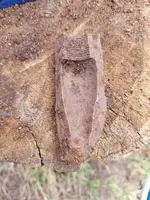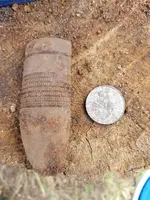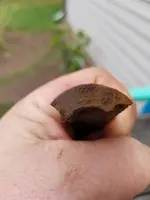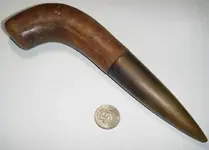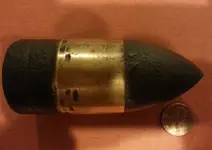You are using an out of date browser. It may not display this or other websites correctly.
You should upgrade or use an alternative browser.
You should upgrade or use an alternative browser.
✅ SOLVED Nees some help.
- Thread starter wisconsinACE
- Start date
Joe-Dirt
Silver Member
- Joined
- Jan 18, 2018
- Messages
- 3,604
- Reaction score
- 11,413
- Golden Thread
- 0
- Location
- Central Massachusetts
- 🏆 Honorable Mentions:
- 1
- Detector(s) used
- Minelab equinox 800 & XP Deus II , 2 Garrett carrots, Minelab find 35 pin pointer, NX6 shovel , 31” Lesche shovel, whites digmaster, Lesche hand trowel, 3-5 gallon buckets full of crappola
- Primary Interest:
- Other
Inside of a manual drill chuck, looks a little small to be artillery
Upvote
0
DCMatt
Gold Member
- Joined
- Oct 12, 2006
- Messages
- 10,472
- Reaction score
- 13,785
- Golden Thread
- 0
- Location
- Herndon Virginia
- Detector(s) used
- Minelab Equinox 600, EX II, & Musketeer, White's Classic
- Primary Interest:
- Metal Detecting
Fragment of a tooth from a digging or trenching machine?
Upvote
0
DCMatt
Gold Member
- Joined
- Oct 12, 2006
- Messages
- 10,472
- Reaction score
- 13,785
- Golden Thread
- 0
- Location
- Herndon Virginia
- Detector(s) used
- Minelab Equinox 600, EX II, & Musketeer, White's Classic
- Primary Interest:
- Metal Detecting
Upvote
0
TheCannonballGuy
Gold Member
- Joined
- Feb 24, 2006
- Messages
- 6,606
- Reaction score
- 13,448
- Golden Thread
- 0
- Location
- Occupied CSA (Richmond VA)
- Detector(s) used
- White's 6000, Nautilus DMC-1, Minelab
- Primary Interest:
- Relic Hunting
Kingskid1611's guess is correct... it is a fragment of an exploded artillery shell. More specifically, it was part of an early-20th Century shell. The ridged area encircling your fragment's "outside" was to keep the shell's copperbrass band-sabot (a.k.a. "driving band") from slipping during firing. The threaded area on the frag's inside held a fuzeplug which screwed into this shell's base.
The photo below shows a late-1800s-to-early-1900s Hotchkiss-Patent artillery shell with a wide brass band-sabot and a base-fuze.
As to "how it got there":
Prior to the 1950s, cities and towns were much smaller... most of the US was very thinly populated agricultural land and forests. Therefore, the US Army could pretty much conduct "Live Firing" practice wherever it wanted to. For example, we civil war relic diggers here in Virginia frequently find fragments and fuzes from World War One artillery shells along the banks of the James River below Richmond. Also lots of 20th Century military bullet-casings.
The photo below shows a late-1800s-to-early-1900s Hotchkiss-Patent artillery shell with a wide brass band-sabot and a base-fuze.
As to "how it got there":
Prior to the 1950s, cities and towns were much smaller... most of the US was very thinly populated agricultural land and forests. Therefore, the US Army could pretty much conduct "Live Firing" practice wherever it wanted to. For example, we civil war relic diggers here in Virginia frequently find fragments and fuzes from World War One artillery shells along the banks of the James River below Richmond. Also lots of 20th Century military bullet-casings.
Attachments
Upvote
0
wisconsinACE
Full Member
- #10
Thread Owner
Kingskid1611's guess is correct... it is a fragment of an exploded artillery shell. More specifically, it was part of an early-20th Century shell. The ridged area encircling your fragment's "outside" was to keep the shell's copperbrass band-sabot (a.k.a. "driving band") from slipping during firing. The threaded area on the frag's inside held a fuzeplug which screwed into this shell's base.
The photo below shows a late-1800s-to-early-1900s Hotchkiss-Patent artillery shell with a wide brass band-sabot and a base-fuze.
As to "how it got there":
Prior to the 1950s, cities and towns were much smaller... most of the US was very thinly populated agricultural land and forests. Therefore, the US Army could pretty much conduct "Live Firing" practice wherever it wanted to. For example, we civil war relic diggers here in Virginia frequently find fragments and fuzes from World War One artillery shells along the banks of the James River below Richmond. Also lots of 20th Century military bullet-casings.
I would have never guessed that that! Especially around this area. What year would these have been used primarily? I'm thinking maybe a war souvenir as there were no military installations anywhere around here.
Last edited:
Upvote
0
Duckshot
Silver Member
- Joined
- Sep 8, 2014
- Messages
- 4,455
- Reaction score
- 9,643
- Golden Thread
- 0
- Primary Interest:
- All Treasure Hunting
I would have never guessed that that! Especially around this area. What year would these have been used primarily? I'm thinking maybe a war souvenir as there were no military installations anywhere around here.
Don't know where in WI you happen to be but there were tons of military installations in WI during WWII, Korea, and Viet Nam that were abandoned long ago. I'm familiar with a few of them in Southeast W mostly because many are public land today. Richard Bong Recreation Area used to be an airbase during WWII. There were a couple of munitions manufacturers right in the City of Milwaukee during WWII and Viet Nam, and Badger Ammunition had a plant and testing site right outside of Vernon Marsh in Waukesha Co. At the Badger plant there are a dozen or so water filled "donut" ponds from testing munitions that are still used by ducks and duck hunters today.
Or, maybe some cow farmer with a Hotchkiss launched one off to keep the neighbor's cattle out of his pasture?

Upvote
0
wisconsinACE
Full Member
- #12
Thread Owner
Don't know where in WI you happen to be but there were tons of military installations in WI during WWII, Korea, and Viet Nam that were abandoned long ago. I'm familiar with a few of them in Southeast W mostly because many are public land today. Richard Bong Recreation Area used to be an airbase during WWII. There were a couple of munitions manufacturers right in the City of Milwaukee during WWII and Viet Nam, and Badger Ammunition had a plant and testing site right outside of Vernon Marsh in Waukesha Co. At the Badger plant there are a dozen or so water filled "donut" ponds from testing munitions that are still used by ducks and duck hunters today.
Or, maybe some cow farmer with a Hotchkiss launched one off to keep the neighbor's cattle out of his pasture?
I am about an hour south of Superior.
Upvote
0
Similar threads
- Replies
- 6
- Views
- 449
- Replies
- 5
- Views
- 361
Users who are viewing this thread
Total: 1 (members: 0, guests: 1)

